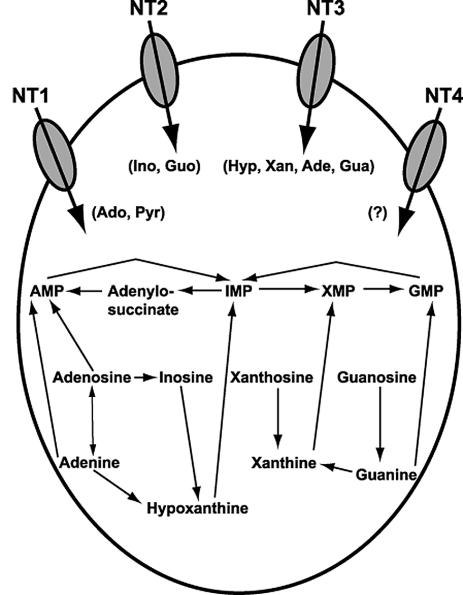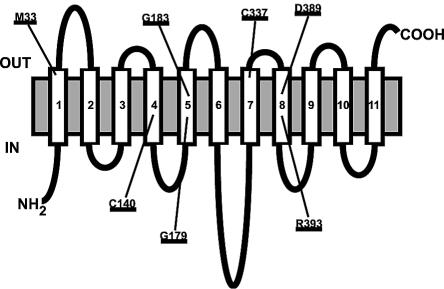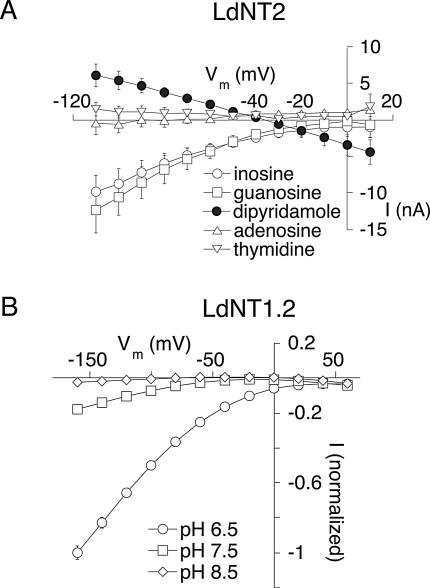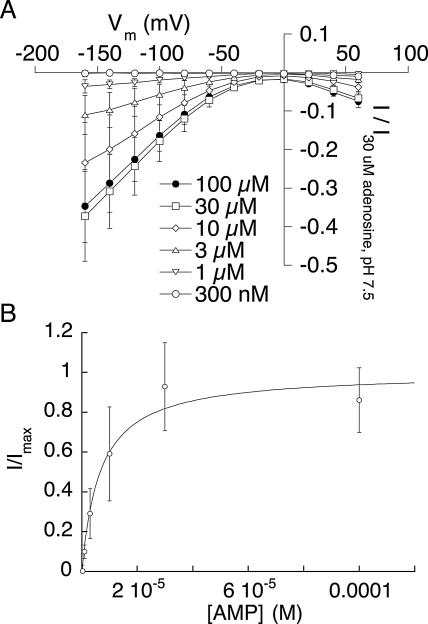Abstract
We show that the mitogen-activated protein (MAP) kinase pathway that responds to osmotic stress in Aspergillus fumigatus is also involved in nutritional sensing. This MAP kinase regulates conidial germination in response to the nitrogen source and is activated upon starvation for either carbon or nitrogen during vegetative growth.
Mitogen-activated protein (MAP) kinases play a central role in regulating cellular homeostasis in microbial eukaryotes in response to environmental changes (3, 4, 7, 9-12, 15-18, 20). We have been studying the role of the MAP kinase SakA in Aspergillus fumigatus, an opportunistic human pathogen. We were interested in SakA because in other fungi homologues of this protein kinase have been shown to play a role in stress responses and pathogenesis (1, 2, 6, 8, 10, 13-15, 19, 21, 22). It is therefore possible that SakA plays a role in pathogenesis and response to immune cell action.
A sakA deletion strain was made by using sakA 5′ and 3′ flanking sequences that were amplified by PCR from genomic DNA (strain AF293) with oligonucleotides (Table 1) that incorporated specific restriction sites that facilitated cloning around the hygromycin phosphotransferase gene (Fig. 1A). The selective marker was first cloned into the EcoRI site of the plasmid Bluescript (5). Deletion of sakA was confirmed by Southern blot analysis (Fig. 1B), and initial experiments were conducted with three independent deletion strains to confirm that phenotypes were associated with deletion of the gene and not an unlinked mutation resulting from transformation. Specific oligonucleotide pairs were used to make PCR probes for the genes msnA, ptpA, pbsA, and actin with genomic DNA as the template (Table 1). Strain AF293 and those derived from it were used throughout these studies and cultured on minimal medium (MM; 70 mM NaNO3, 7 mM KCl, 2 mM MgSO4, 12 mM KPO4 [pH 6.8], trace elements, 1% [wt/vol] glucose) or complete medium (CM), which is MM supplemented with yeast extract (0.1%, wt/vol), peptone (0.2%, wt/vol), and tryptone (0.1%, wt/vol) (Difco Laboratories, Detroit, Mich.). For experiments involving different nitrogen sources MM salts were prepared without sodium nitrate and the nitrogen source was added to a final concentration of 10 mM prior to sterilization. For nitrogen and carbon starvation experiments, mycelia were grown for 14 h at 37°C in yeast extract (0.5%, wt/vol)-glucose (1%, wt/vol) (YG) medium and washed with sterile water. The mycelium was then suspended in MM lacking nitrogen or glucose and incubated for 30 min at 37°C. The control was maintained in YG.
TABLE 1.
Oligonucleotides used during this study
| Oligo- nucleotide | Sequence | Product size (kb) |
|---|---|---|
| sakA-1 | GTTTTGACATCCTCATCTGTCG | 2.2 |
| sakA-2 | GTACGAATTCAGATTGCATCCTG | |
| sakA5′-1 | TCTACCGCGGCAGGTAAAAGC | 2.7 |
| sakA5′-2 | GATCTCAAACTAGTGGATGTTCAACG | |
| sakA3′-1 | CCTTATCGATTGGAAACGTCTAATCAC | 2.3 |
| sakA3′-2 | CTCTTCGGTACCCATGTATCCG | |
| ptp-5′ | CATGAAGCTTGAATACAGCAATAAGCGC | 0.84 |
| ptp-3′ | CTTTCAAAGCTTAAGACAAACTGGCTC | |
| msn-5′ | GAACGAAGCTTGGAAGATCTGGACG | 0.54 |
| msn-3′ | AGCAAGCTTGTCGCTGCGAGAG | |
| pbs-5′ | AACCAAGCTTGAAACTGTCAGATGCC | 1.3 |
| pbs-3′ | TGCAAAGCTTTCTGCCTCTTGTAGGTGC | |
| actin 5′ | GAAGTTGCTGCTCTCGTCATCGAC | 1.7 |
| actin 3′ | GCACTTGCGGTGAACGATCGAAG |
FIG. 1.
Deletion of the sakA gene. (A) Strategy used to delete sakA. The hph-selective marker was flanked by DNA sequences from around sakA. Integration of the linear molecule by homologous recombination replaces sakA with hph in the chromosome. (B) Southern blot showing the wild-type and ΔsakA patterns of hybridization. One representative is shown for each. (C) Northern blots of RNA from the ΔsakA strain and AF293, the wild-type strain, exposed to increasing concentrations of NaCl. The first lane in each set had CM; lanes 2 to 6 had in addition 0.25, 0.5, 0.75, 1, and 1.5 M NaCl, respectively. The probes used for hybridization of each set of lanes are indicated on the left.
We assessed the conservation of the SakA MAP kinase signaling pathway in A. fumigatus using Northern blotting to measure changes in the abundances of transcripts for the genes msnA, ptpA, pbsA, and, as a control, actin. We looked at these genes because the mRNAs for msnA, ptpA, and pbsA are known to increase in response to osmotic stress in other fungi (3, 9, 12). We found that the abundances of transcripts for msnA, ptpA, and pbsA all increased in response to increasing osmotic stress in the wild-type control strain but not in the sakA deletion (ΔsakA) strain (Fig. 1C). This demonstrates that the transcriptional response to osmotic stress is conserved in A. fumigatus. Similarly, we found levels of sakA transcripts increased in response to hydrogen peroxide, a response also seen in some fungi (data not shown) (3, 9, 12).
We next examined the growth response of actively growing germlings and conidia to increased osmolarity. We found that germlings of the ΔsakA strain undergo growth arrest in response to increased osmolarity, whereas conidia germinated in high-osmolarity medium were able to grow hyphae but did so more slowly than the parental control, suggesting that signaling through this MAP kinase pathway in conidia is different from that in growing germlings (Fig. 2). We also observed that ΔsakA strains failed to produce a pigment secreted into the medium of plates by control strains (data not shown).
FIG. 2.
Photomicrographs of the wild-type parental strain AF293 and a ΔsakA strain grown continuously (continuous) in CM with 1 M NaCl or shifted to CM with 1 M NaCl after 5 h of germination in CM (germinated). Fields of germlings were also photographed after 11 and 13 h of growth. Scale bar, 20 μm.
During the course of these initial studies, we found that conidia of the ΔsakA strain and the parent germinated differently on MM and CM (Fig. 3A). On CM the parental and ΔsakA strains germinated equally well. In contrast, on MM the wild-type strain germinated more slowly than the ΔsakA strain. A major difference between MM and CM is the inclusion of yeast extract, peptone, and tryptone, all sources of reduced nitrogen. We therefore tested germination of the wild-type and ΔsakA strains on MM containing different nitrogen sources (Fig. 3B). Conidia of the wild-type strain germinated more slowly than those of the ΔsakA strain on MM containing the poor nitrogen source sodium nitrate or sodium nitrite, but both strains germinated equally well on MM with the reduced-nitrogen source ammonium chloride or proline. When phenylalanine was used as a nitrogen source, both strains germinated less well, suggesting that this amino acid is less suitable as a nitrogen source. Interestingly, we found no difference in germination on a variety of carbon sources, including glycerol, acetate, sorbitol, and lactose (data not shown). These results indicate that SakA functions to negatively regulate conidial germination in response to less-preferred nitrogen sources but not in response to the carbon sources.
FIG. 3.
Conidial germination is altered in the sakA deletion strain and is dependent on the nitrogen source. (A) Conidial germination in CM is the same for AF293 and ΔsakA strains after 6 h of growth. In contrast, on MM the AF293 conidia were significantly slower to germinate than those of the ΔsakA strain. (B) The germination of conidia depends on the nitrogen source in the medium.
Finally, because of the newly discovered role for SakA in sensing nitrogen in the medium, we investigated the effect of starvation for carbon and nitrogen on transcriptional activation of the genes in this pathway (Fig. 4). When hyphae are transferred from rich medium to MM lacking either a nitrogen or carbon source, we find a robust activation of transcription for sakA but not for msnA, ptpA, or pbsA and no changes in the ΔsakA strain are observed.
FIG. 4.
sakA RNA levels change following starvation for nitrogen or glucose. Northern blots of RNA prepared from hyphae from ΔsakA and AF293 strains starved for nitrogen (lanes -N) or glucose (lanes -C) for 30 min. The probes used for hybridization of each set of lanes are indicated on the left.
In summary, the osmotic stress response pathway in A. fumigatus is conserved. We have shown that this MAP kinase pathway negatively regulates conidial germination and is activated in response to starvation for nitrogen or carbon sources.
Acknowledgments
This research was supported by National Institutes of Health grant AI051144 (G.S.M.) and Cancer Center Support Grant CA16672.
We acknowledge that preliminary sequence data were obtained from The Institute for Genomic Research website at http://www.tigr.org. We also acknowledge the helpful discussions we had with Mike Gustin of Rice University and Dimitrios Kontoyiannis of MDACC during the course of these studies.
REFERENCES
- 1.Alonso-Monge, R., F. Navarro-Garcia, E. Roman, A. I. Negredo, B. Eisman, C. Nombela, and J. Pla. 2003. The hog1 mitogen-activated protein kinase is essential in the oxidative stress response and chlamydospore formation in Candida albicans. Eukaryot. Cell 2:351-361. [DOI] [PMC free article] [PubMed] [Google Scholar]
- 2.Brachmann, A., J. Schirawski, P. Muller, and R. Kahmann. 2003. An unusual MAP kinase is required for efficient penetration of the plant surface by Ustilago maydis. EMBO J. 22:2199-2210. [DOI] [PMC free article] [PubMed] [Google Scholar]
- 3.Brewster, J. L., T. de Valoir, N. D. Dwyer, E. Winter, and M. C. Gustin. 1993. An osmosensing signal transduction pathway in yeast. Science 259:1760-1763. [DOI] [PubMed] [Google Scholar]
- 4.Buck, V., J. Quinn, T. Soto Pino, H. Martin, J. Saldanha, K. Makino, B. A. Morgan, and J. B. Millar. 2001. Peroxide sensors for the fission yeast stress-activated mitogen-activated protein kinase pathway. Mol. Biol. Cell 12:407-419. [DOI] [PMC free article] [PubMed] [Google Scholar]
- 5.Carroll, A. M., J. A. Sweigrad, and B. Valent. 1994. Improved vectors for selecting resistance to hygromycin. Fungal Genet. Newsl. 41:22. [Google Scholar]
- 6.Di Pietro, A., F. I. Garcia-MacEira, E. Meglecz, and M. I. Roncero. 2001. A MAP kinase of the vascular wilt fungus Fusarium oxysporum is essential for root penetration and pathogenesis. Mol. Microbiol. 39:1140-1152. [PubMed] [Google Scholar]
- 7.Gustin, M. C., J. Albertyn, M. Alexander, and K. Davenport. 1998. MAP kinase pathways in the yeast Saccharomyces cerevisiae. Microbiol. Mol. Biol. Rev. 62:1264-1300. [DOI] [PMC free article] [PubMed] [Google Scholar]
- 8.Hamer, J. E., and N. J. Talbot. 1998. Infection-related development in the rice blast fungus Magnaporthe grisea. Curr. Opin. Microbiol. 1:693-697. [DOI] [PubMed] [Google Scholar]
- 9.Han, K. H., and R. A. Prade. 2002. Osmotic stress-coupled maintenance of polar growth in Aspergillus nidulans. Mol. Microbiol. 43:1065-1078. [DOI] [PubMed] [Google Scholar]
- 10.Jenczmionka, N. J., F. J. Maier, A. P. Losch, and W. Schafer. 2003. Mating, conidiation and pathogenicity of Fusarium graminearum, the main causal agent of the head-blight disease of wheat, are regulated by the MAP kinase gpmk1. Curr. Genet. 43:87-95. [DOI] [PubMed] [Google Scholar]
- 11.Kato, T., Jr., K. Okazaki, H. Murakami, S. Stettler, P. A. Fantes, and H. Okayama. 1996. Stress signal, mediated by a Hog1-like MAP kinase, controls sexual development in fission yeast. FEBS Lett. 378:207-212. [DOI] [PubMed] [Google Scholar]
- 12.Kawasaki, L., O. Sanchez, K. Shiozaki, and J. Aguirre. 2002. SakA MAP kinase is involved in stress signal transduction, sexual development and spore viability in Aspergillus nidulans. Mol. Microbiol. 45:1153-1163. [DOI] [PubMed] [Google Scholar]
- 13.Kinane, J., and R. P. Oliver. 2003. Evidence that the appressorial development in barley powdery mildew is controlled by MAP kinase activity in conjunction with the cAMP pathway. Fungal Genet. Biol. 39:94-102. [DOI] [PubMed] [Google Scholar]
- 14.Leberer, E., D. Harcus, D. Dignard, L. Johnson, S. Ushinsky, D. Y. Thomas, and K. Schroppel. 2001. Ras links cellular morphogenesis to virulence by regulation of the MAP kinase and cAMP signalling pathways in the pathogenic fungus Candida albicans. Mol. Microbiol. 42:673-687. [DOI] [PubMed] [Google Scholar]
- 15.Mayorga, M. E., and S. E. Gold. 1999. A MAP kinase encoded by the ubc3 gene of Ustilago maydis is required for filamentous growth and full virulence. Mol. Microbiol. 34:485-497. [DOI] [PubMed] [Google Scholar]
- 16.Millar, J. B. 1999. Stress-activated MAP kinase (mitogen-activated protein kinase) pathways of budding and fission yeasts. Biochem. Soc. Symp. 64:49-62. [PubMed] [Google Scholar]
- 17.Muller, P., C. Aichinger, M. Feldbrugge, and R. Kahmann. 1999. The MAP kinase kpp2 regulates mating and pathogenic development in Ustilago maydis. Mol. Microbiol. 34:1007-1017. [DOI] [PubMed] [Google Scholar]
- 18.Navarro-Garcia, F., M. Sanchez, J. Pla, and C. Nombela. 1995. Functional characterization of the MKC1 gene of Candida albicans, which encodes a mitogen-activated protein kinase homolog related to cell integrity. Mol. Cell. Biol. 15:2197-2206. [DOI] [PMC free article] [PubMed] [Google Scholar]
- 19.Shim, W. B., and L. D. Dunkle. 2003. CZK3, a MAP kinase kinase kinase homolog in Cercospora zeae-maydis, regulates cercosporin biosynthesis, fungal development, and pathogenesis. Mol. Plant-Microbe Interact. 16:760-768. [DOI] [PubMed] [Google Scholar]
- 20.Soto, T., F. F. Beltran, V. Paredes, M. Madrid, J. B. Millar, J. Vicente-Soler, J. Cansado, and M. Gacto. 2002. Cold induces stress-activated protein kinase-mediated response in the fission yeast Schizosaccharomyces pombe. Eur. J. Biochem. 269:5056-5065. [DOI] [PubMed] [Google Scholar]
- 21.Takano, Y., T. Kikuchi, Y. Kubo, J. E. Hamer, K. Mise, and I. Furusawa. 2000. The Colletotrichum lagenarium MAP kinase gene CMK1 regulates diverse aspects of fungal pathogenesis. Mol. Plant-Microbe Interact. 13:374-383. [DOI] [PubMed] [Google Scholar]
- 22.Xu, J. R., and J. E. Hamer. 1996. MAP kinase and cAMP signaling regulate infection structure formation and pathogenic growth in the rice blast fungus Magnaporthe grisea. Genes Dev. 10:2696-2706. [DOI] [PubMed] [Google Scholar]






